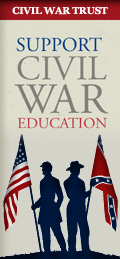|
Coddington publishes book of 'Faces'
By Michael J. Winey
Civil War News
April 2005
The name Ron Coddington will not be unfamiliar to readers of The Civil War News since you peruse his column "Faces of War" in each issue. The book is a collection of some of those articles plus an extensive array of others, each written in a similar fashion and illustrated by a single image of the subject.
The book begins with a synopsis of the carte de visite photograph and its place in the history of photography. The production process made the printing of photographs relatively inexpensive and by the time of the first shots at Fort Sumter it was a process familiar to and used by hundreds of photographers across the country. A combination of lenses increased the output of images so that multiple images could be made allowing for the printing of several pictures all exactly alike, except for a slight difference in angle.
The carte de visite became the major way for a soldier to have his likeness made, which he then sent home to family members, sweethearts or to be traded to his messmates. Hundreds of thousands of cartes de visite were made and their abundance today in museums and private collections, not to mention their sale at Civil War shows and on the Internet, attests to their significant wartime production and great popularity.
Faces of the Civil War is the first in a series of volumes which the author hopes to compile in the future. The format, following the preface and discussion of the carte de visite, is a simple, straightforward biography of each soldier pictured. For this volume the author has chosen to present his images in a wartime chronology of each soldier's most interesting or poignant moment of his service. Thus we read about soldiers from First Bull Run to Bentonville.
Numerous biographies tell of the soldier's death or mortal wounding on the battlefield. Others tell of the soldier suffering from wounds or disease contracted during the war and living with those maladies long after the fighting was over. Each story illustrates the image and places a personality to a human being who is often forgotten more than a century later.
The author uses images of enlisted men and junior grade officers for his biographical vignettes. Not all the images featured are from the Eastern Theater. In his wide range of collecting author Coddington has also acquired many faces of the western boys as well.
The photograph captions are brief. The author lists the name of the soldier along with the highest rank he attained during the war and the last assignment in which he served. Then he gives the type of image (all cartes de visite in this volume), the photographer's backmark, life dates of the photographer when known and a circa date for the image presented.
The last known rank and unit of the individual pictured can be somewhat disquieting at times. For instance, an officer wearing the distinctively trimmed frock coat of the 33rd New Jersey Infantry is listed as being in the Twentieth Veteran Reserve Corps. He is not wearing the uniform of the VRC nor the rank he had as a member of the VRC. For us uniform aficionados that drives us nuts! We like to see the image identified as to what unit he belonged to when his image was made and the rank seen in that image.
There are a few bloopers but they are easily overlooked by anyone familiar with the basics of Civil War history. All in all this is a well-written, well-documented and interesting little book. If you like to look at soldier's photographs and like to read short biographies of those obscure individuals who played the major role in winning the war for the Union, this book is highly recommended. It is an easy read and would make a great book for the teenager who is developing into an avid Civil War buff.
|
|
